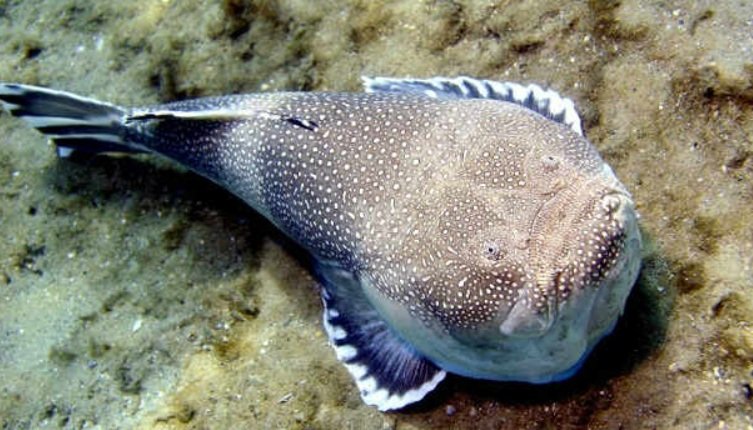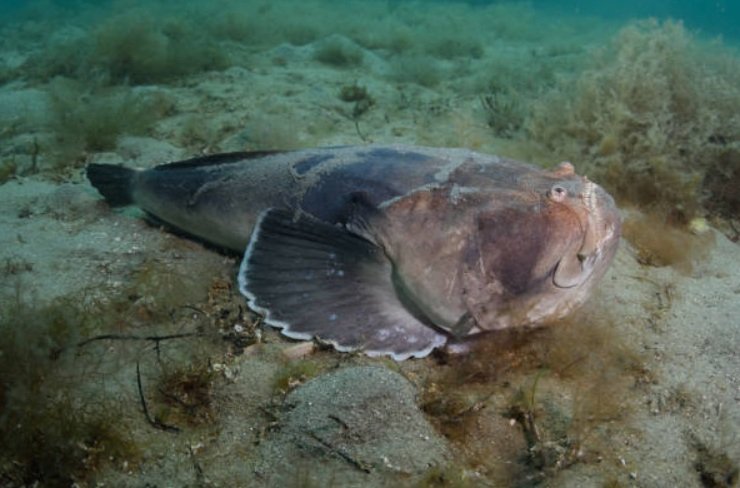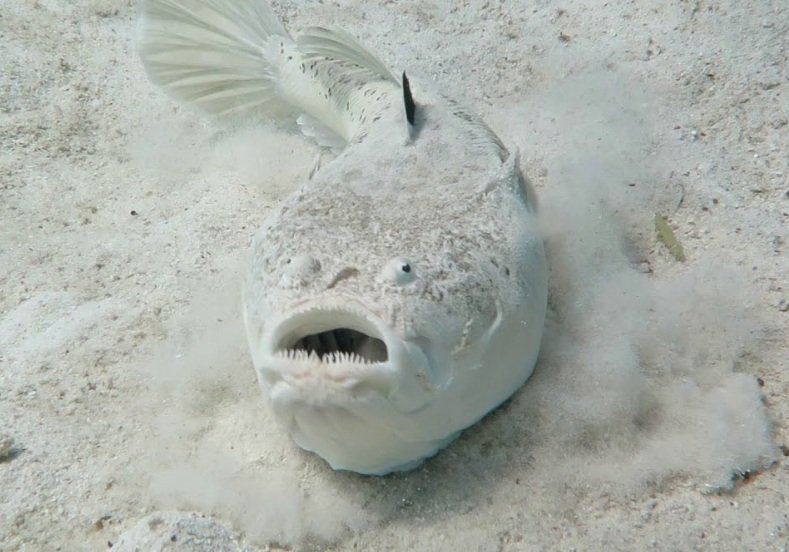
Quick Top 10 Facts about Stargazer Fish
| SCIENTIFIC NAME | Uranoscopus spp. |
| CLASSIFICATION | KINGDOM: Animalia PHYLUM: Chordata CLASS: Actinopterygii ORDER: Perciformes FAMILY: Uranoscopidae GENUS: Uranoscopus SPECIES: Various species within this genus |
| SIZE | Length: Up to 24 inches (60 cm), depending on the species |
| HABITAT | Coastal waters, primarily in the Indo-Pacific region, but also found in parts of the Atlantic Ocean |
| DIET | Carnivorous; primarily feeds on small fish, crustaceans, and other invertebrates |
| SPECIES | Stargazer Fish, named for their upward-facing eyes and unique predatory behavior |
| COUNTRY | Found in various marine environments worldwide, particularly in shallow coastal areas |
| GESTATION PERIOD | Oviparous; they lay eggs which hatch into larvae, with no specific gestation period |
| LIFE SPAN | Up to 5–10 years, depending on the species |
| CONSERVATION STATUS | Not endangered; however, some species may be threatened by habitat destruction and overfishing |
Amazing Facts About Stargazer Fish
1. They have upward-facing eyes
The Stargazer Fish is named for its unique upward-facing eyes, which allow it to watch for prey above the sand while buried.
2. They can generate electric shocks
Some species of Stargazer Fish are capable of generating electric discharges, which they use to stun prey or defend themselves.
3. They are ambush predators
Stargazers bury themselves in the sand, using their specialized eyes to spot prey passing overhead before quickly striking.
4. They have venomous spines
Certain species have venomous spines near their gills and dorsal fins that they use to defend themselves against predators.
5. They are typically bottom-dwellers
Stargazer Fish are primarily found on the ocean floor, where they camouflage themselves in sand or mud to remain hidden from predators and prey alike.
6. They are skilled hunters
Stargazer Fish have a specialized mouth and jaw structure that enables them to gulp prey efficiently when it comes within range.
7. They are nocturnal hunters
Most Stargazer Fish are more active at night, hunting when their prey is also more active.
8. They can grow quite large
Depending on the species, Stargazer Fish can reach lengths of up to 2 feet (60 cm), though many species remain smaller.
9. They have a unique appearance
With their large, bulging eyes and flattened bodies, Stargazer Fish have an eerie and distinctive look that sets them apart from other fish.
10. They are found in diverse ocean habitats
Stargazer Fish can be found in a wide range of habitats, from sandy bottoms and shallow waters to deeper, more rugged environments.
Intriguing Facts about Stargazer Fish
Stargazer fish, also known as Uranoscopidae, are captivating creatures found in coastal waters worldwide. These unique fish possess remarkable adaptations, including upward-facing eyes that aid in their predatory ambushes. With venomous spines as a defense mechanism, stargazer fish are formidable predators despite their small size. Their camouflage abilities and electric shock capabilities further enhance their hunting prowess.
From the Atlantic Ocean to the Indo-Pacific, these elusive fish thrive in sandy or muddy habitats, evading detection with their expert blending techniques. Understanding the diverse species of stargazer fish, such as the Yellow Stargazer and the Southern Stargazer, sheds light on the richness of marine ecosystems. Discovering more about these intriguing creatures reveals the wonders of our oceans and the intricate web of life within them.
Exploring the Unique Traits of Stargazer Fish
Stargazer fish are a distinct species distinguished by their peculiar look and intriguing habits. The upward-facing eyes on these fish’s heads allow them to ambush their food from below. Additionally, they can swiftly catch their prey thanks to their huge jaws and keen fangs. Usually located in sandy or muddy coastal areas, stargazer fish burrow themselves in order to hide and wait for unwary food to swim past.

Understanding the Defensive Mechanisms of Stargazer Fish
Venomous spines on their backs serve as another protection mechanism for stargazer fish against predators. When threatened, the stargazer fish may be quite dangerous because of its severe, stinging spines. Stargazer fish are renowned as fierce predators despite their tiny size, using ambush and concealment strategies to capture food much bigger than themselves. Because they are adept at hiding in their environment, neither predators nor prey can easily identify them.
Adaptations of Stargazer Fish for Survival
Stargazer fish are amazing animals that have developed special traits to enable them to live in their oceanic surroundings. Their capacity to burrow themselves into the sand, together with their poisonous spines and raptorial tendencies, makes them a very dangerous predator in the aquatic realm. The ecology benefits greatly from the presence of stargazer fish, despite their relatively unknown status compared to other marine species. They also serve as a reminder of the variety and intriguing life found in our seas.
Unveiling the Mysteries of Stargazer Fish
The scientific name for the peculiar and fascinating species that lives in the ocean’s depths is Uranoscopidae, or the stargazer fish. This amazing fish is well-known for both its unique appearance and intriguing habits. With its amazing physical characteristics, ability to conceal itself, capacity for electric shock, and distinct hunting strategies, the stargazer fish is undoubtedly a spectacular species. The presence of marine life in the ocean enhances its richness and wonder. Even though seeing a stargazer fish may be uncommon, knowing about these interesting animals enables us to recognize the astounding variety of life that exists under the surface of the ocean.
Distinctive Physical Attributes of Stargazer Fish
The stargazer fish’s upward-facing eyes are among its most characteristic traits. The Stargazer is able to bury itself in the sand and still see its surroundings because, in contrast to other fish, its eyes are located atop its head. This adaptability determines its ability to seek out and fend off predators.
The stargazer fish’s enormous, upward-facing mouth is yet another amazing anatomical feature. By quickly expanding its mouth and creating a vacuum that draws in gullible smaller fish or crustaceans, the fish uses this unusual characteristic to ambush its prey.
Camouflage and Hunting Strategies of Stargazer Fish
The stargazer fish has excellent camouflage skills. Its speckled patterns and colors on its body often blend in perfectly with the sand-colored ocean bottom, making it almost undetectable to predators and prey alike. Its eyes and mouth remain hidden as it buries itself in the sand, where it waits for naive prey to swim past.
When it gets within striking range, the stargazer fish quickly expands its mouth to seize its food and generates a strong suction force. The stargazer fish is an effective and successful predator because of its distinctive hunting strategy and superb camouflage.
Electric Shock Capabilities of Stargazer Fish
In contrast to other fish, the stargazer has an amazing capacity to produce electric shocks. These shocks are triggered by the specialized organs behind their eyes. Although the precise function of this electric shock is unknown, experts think it might be used to stun prey or scare off would-be predators.
It is noteworthy that although a stargazer fish’s electric shock cannot kill humans, it may inflict pain and suffering. Therefore, if you come across these fish, you should handle them carefully.

Habitat and Distribution Patterns of Stargazer Fish
The majority of stargazer fish can be found in shallow coastal areas with muddy or sandy ocean bottoms. They are often seen in areas such as the Atlantic Ocean, Mediterranean Sea, and Indo-Pacific. They may be difficult to identify, even for seasoned divers and marine aficionados, because of their outstanding ability to blend in with their environment.
These amazing animals would much rather hide in the sand during the day and come out at night to hunt. Their nighttime lifestyle further heightens the mystery around them.
Types and Varieties of Stargazer Fish
There are many different species of stargazer fish, and each has special traits and adaptations of its own. Several species frequently occur, including the Yellow Stargazer (Astroscopus zephyreus), the Southern Stargazer (Astroscopus y-graecum), and the Northern Stargazer (Astroscopus guttatus). Each species has unique preferences for habitat and patterns of dispersion, even if they are quite similar to one another.
FAQ (Frequently Asked Questions) about Stargazer Fish
Q: What is a Stargazer Fish?
Ans: The Stargazer Fish is a species of predatory fish known for its unique appearance, with its eyes located on top of its head, which allows it to “stargaze.” They are bottom-dwelling fish found in tropical and subtropical waters. Stargazers are known for their ability to ambush prey using their excellent camouflage and quick strikes.
Q: Where does the Stargazer Fish live?
Ans: Stargazer Fish are primarily found in the sandy or muddy ocean floors of tropical and subtropical regions around the world. They inhabit depths ranging from shallow coastal waters to deeper parts of the continental shelf. They often bury themselves in sand to remain hidden while waiting for prey to come near.
Q: What does the Stargazer Fish eat?
Ans: Stargazer Fish are carnivorous predators. They feed on a variety of smaller fish, crustaceans, and invertebrates. Stargazer Fishes use their excellent camouflage and ambush hunting style to surprise and capture their prey. They are opportunistic feeders, often waiting motionless in the sand until their prey comes within range.
Q: How big does the Stargazer Fish get?
Ans: Stargazer Fish typically grow to lengths of 12 to 18 inches (30 to 45 cm), though some species can grow even larger. They have a compact and muscular body, which helps them remain hidden while hunting for prey.
Q: How does the Stargazer Fish defend itself?
Ans: The Stargazer Fish uses its excellent camouflage and ability to bury itself in sand or mud as its primary defense mechanism. Some species also possess venomous spines near their gills, which they can use to protect themselves from potential predators. Additionally, the fish’s ability to generate a mild electric shock may serve as another defense tactic.
Q: What is unique about the Stargazer Fish?
Ans: One of the most unique features of the Stargazer Fish is its eyes, which are located on top of its head. This positioning allows the fish to lie buried in the sand and observe passing prey above. Stargazers also have electroreceptors near their heads, and some species can generate a mild electric charge, which may help them navigate or even stun prey.
Q: Are Stargazer Fish dangerous?
Ans: Stargazer Fish are not typically dangerous to humans but can be hazardous if handled improperly. Their venomous spines can cause painful stings, and some species can deliver a mild electric shock if threatened. However, they are generally not aggressive toward humans unless provoked.
Q: How long do Stargazer Fish live?
Ans: Stargazer Fish typically live 5 to 10 years in the wild, depending on the species. They face many natural threats, including predators, but their ability to stay hidden and ambush prey allows them to survive for long periods.
Q: Can Stargazer Fish be kept in aquariums?
Ans: Stargazer Fish are not commonly kept in aquariums due to their specific habitat needs. They require sandy or muddy substrates to bury themselves and often remain hidden. Their venomous spines and electric abilities can also pose a challenge for home aquariums. They are best left in their natural habitat where they can thrive.
#StargazerFish, #MarineFish, #PredatoryFish, #OceanPredators, #BottomDwellingFish, #FishFacts, #ElectricFish, #FishCamouflage, #AquariumFish, #MarineLife
Our sources and references about Stargazer Fish
1: Wikipedia – Stargazer Fish
2: MarineBio – Stargazer Fish
3: FishBase – Stargazer Fish
4: Aquatic Community – Stargazer Fish


